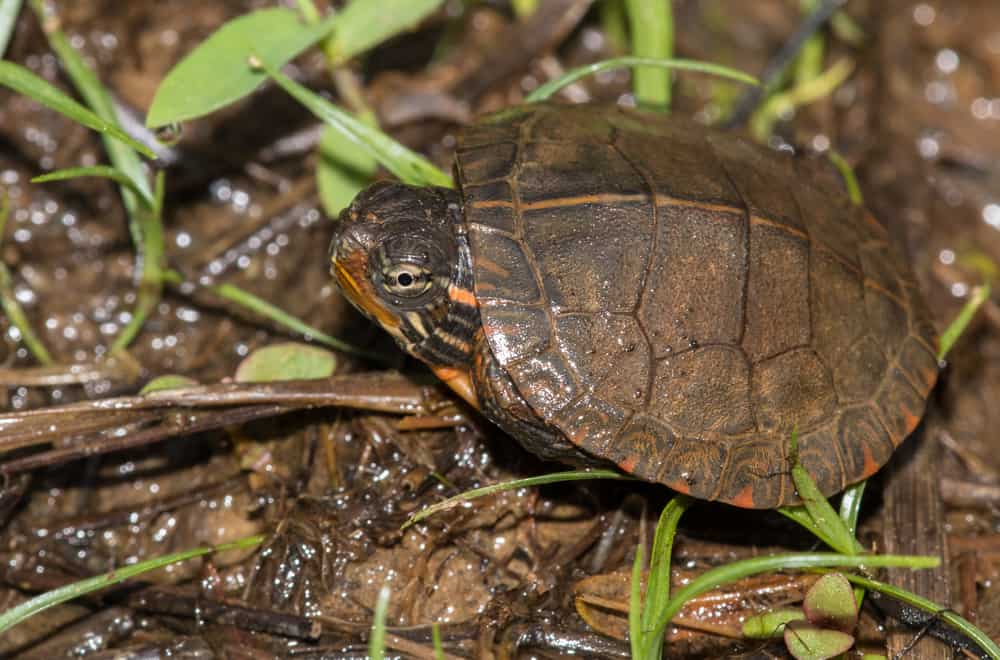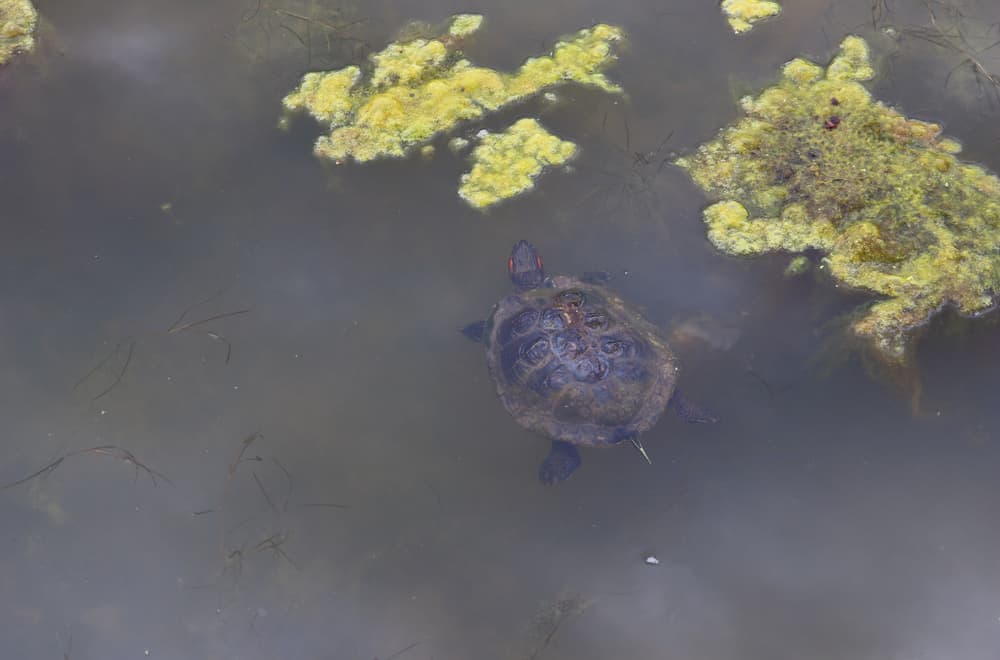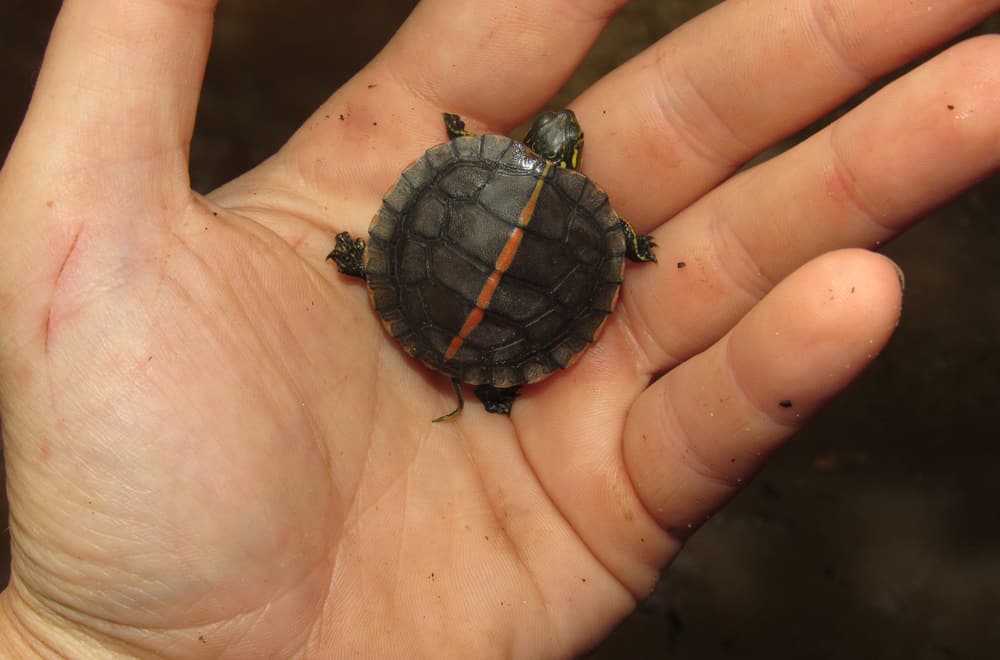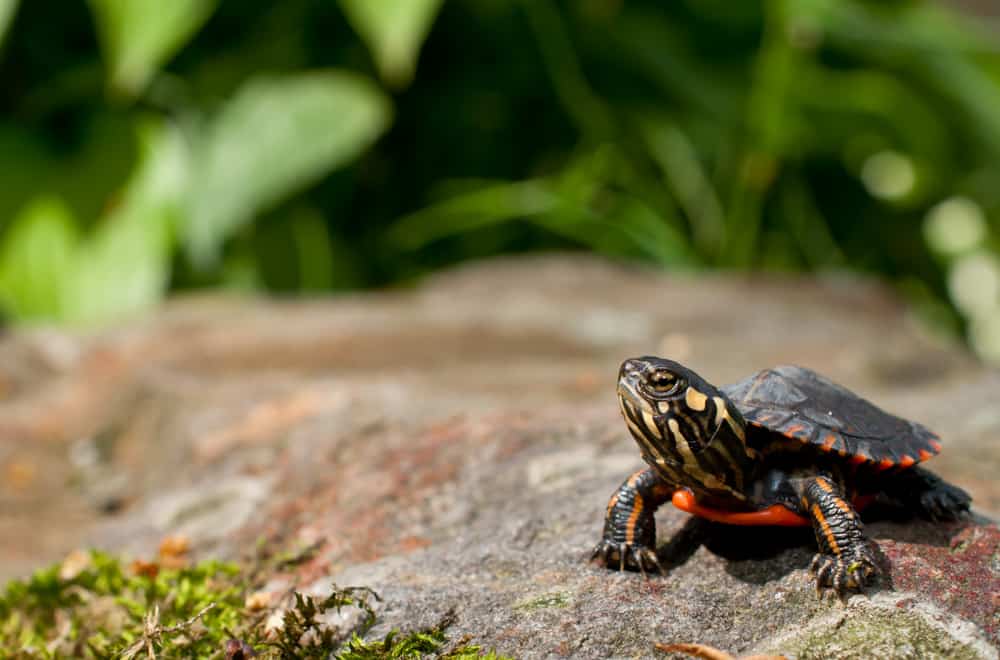The baby painted turtles get tough love from their mother – after she lays her eggs, she provides no care for the hatchlings.
When the babies come out of the nest, which is typically at night, they are left alone to find water and survive.
Let’s discuss how the baby painted turtles do that, along with some basic information about the species.
Habits and Biology of the Baby Painted Turtle
These species are mainly found along the coasts from the Atlantic to the Pacific. They can be found in 45 American states and 18 Canadian states.
Painted turtles like to dwell in fresh water and can be found in lakes, ponds, and marshy areas. They basically live a life of leisure, basking in the sun for five or six hours daily. When they are not sunbathing, they eat.
There are four subspecies of the Painted Turtle:
- Eastern Painted Turtle
- Midland Painted Turtle
- Southern Painted Turtle
- Western Painted Turtle
Size
The female painted turtle is longer in body size than their male counterparts. The female varies in size between four and ten inches in size, and the males are three to six inches.
Body
Under the hard external shell of the turtle is soft, fleshy skin.
Coloration
The shells are typically olive or black in color. The skin of the turtle depends on the color of the shell. The lower portion of the shell is red or yellow, while the middle part of the shell is dark-colored. The neck, legs, and tail are dotted with yellow and red marks.
Head
The head of the painted turtle is distinctive. The face has yellow stripes, with a large yellow spot and streak behind each eye, and on the chin, it has two wide yellow stripes that meet at the tip of the jaw.
Sexual Dimorphism
The male of the species is the one with long, pretty nails. They touch the cheeks of their partners to express love. This species mate from mid-April to the end of July. When they are prepared to mate, they swim to the bottom of the water. The females lay four to 20 eggs out in the open.
Even though painted turtles are in water most of the time, the female turtles are amniotes, meaning they lay their eggs on land. They like their nests to dug in soft, sandy soil with good sun exposure. The turtle digs the nest with her hind feet, usually within 200 meters of the water.
After hatching, the babies grow rapidly. The development of the females is faster than the males. The male painted turtle reaches sexual maturity between two and four years, the female between six and ten years.
A fun fact: Painted turtles cannot move their tongues freely on the land, so they must eat in the water to manipulate their food and wash it down.
Life Span
The average life span of a painted turtle is 20 to 30 years. They have been known to live over 50, however.
Do Baby Painted Turtles Eat Dirt?
No. Baby painted turtles don’t eat dirt.
What Do Baby Painted Turtles Like to Eat Most?
Baby painted turtles have the same diet as adult painted turtles. The only difference is that babies and juveniles prefer to eat more meat than an adult turtle.
Even if they are omnivorous as a species, juveniles and babies are typically carnivorous. Even though they like plants, baby painted turtles will eat more meat because they need protein to grow faster.
Painted turtles are omnivorous, meaning they will eat fruits, vegetables, and meat. Here is a list of what a painted turtle will typically eat:
- Bugs
- Fish
- Fruits
- Insects
- Meat
- Newts
- Pellets
- Snails
- Vegetables
- Vegetation
- Water plants
- Worms
Many people enjoy keeping painted turtles as pets. Here are three foods that are rated five stars by Amazon customers that can ensure the good health of your pet.
1. Tetra ReptoMin Floating Food Sticks for Aquatic Turtles
- For aquatic turtles, frogs, and newts. Scientifically formulated for small aquatic pets.
- Has precise amounts of calcium, vitamin C, and nutrients to support vitality and good health.
- Scientifically formulated and proven to be accepted by dozens of species. Easy to digest
- Feed once or twice a day, only as much as your turtle can consume within a few minutes
2. Zoo Med Natural Aquatic Turtle Food
- No artificial preservatives or colors
- 25% protein
- For turtles over 6”
- 5/16” pellets
3. Mazuri Aquatic Turtle Diet
- Nutritionally complete. No supplements are required.
- A floating diet that mimics natural feeding behaviors
- High quantity of fish and animal proteins. Meets the requirements of carnivorous species.
- Contains vitamin E
Tips to Feed Baby painted turtles
The best way to feed your painted turtle pet is to give it dried insects. The most popular insect you will find is dried crickets. Dried crickets are especially good for painted turtles because they have little fat and a lot of protein.
Painted turtles usually eat any kind of water plant. All aquatic plants that are available in a pet shop will be suitable for your turtle. However, they will not look good for more than a couple of days.
Most pellets labeled for turtles are good. Fish pellets are also good. They contain basically the same ingredients. A good pellet should contain a healthy amount of protein, usually between 25% to 30%.
In the wild, painted turtles eat the same things as pet turtles. The difference being, they won’t encounter cooked meat or food pellets in the wild. In the wild, they are limited to what they can find, not to what someone feeds them.
When it comes to meat, they will rely on small insects, fish if they can catch them, and any other kind of meat they can scavenge. The most abundant food source for painted turtles is insects and water plants.
Most ponds, lakes, and rivers are full of water plants. Insects are basically everywhere, so there is never a shortage, especially in dense vegetation areas where the painted turtles live.
If you want your baby painted turtle to grow into a healthy adult turtle, feed him a balanced diet.
Foods Baby or Adult Painted Turtles Should Avoid
Painted turtles will usually eat any fish they can catch, not caring what type it is. In general, they will eat small fish that are easier to catch and will not resist too much.
If keeping a painted turtle as a pet, keep in mind when feeding your turtle that any fish you feed them should always come from a pet store and not from a body of water. Wild fish contain bacteria that the turtle is not used to, and health problems can develop.
Here are some fish that should not be fed to your baby or adult painted turtle.
- Carp
- Feathered Minnow
- Gizzard Shad
- Goldfish
- Rosy Red Minnow
Some vegetables contain high doses of oxalates, which interfere with calcium absorption resulting in health issues. Here are some vegetables you should not feed your baby or adult painted turtle.
- Beetroot
- Chard
- Endive
- Potatoes
- Rhubarb
- Spinach
FAQs
1. What is the first thing to do when considering getting a turtle for a pet?
- The first step in owning a pet turtle is understanding the great responsibility involved in taking care of a turtle. Turtles require a great deal of care, with basic needs to be met.
2. Do turtles carry germs or diseases?
- All animals carry germs. Some turtles carry the disease salmonella. There is no way of knowing which turtles carry the disease.
- Handwashing is necessary after handling them. If you have children around your turtle, make sure they do not put their hands in their mouths and ensure they wash their hands after handling.
3. Can there be more than one turtle in one tank?
- Young turtles get along well together. However, as they age, older and mature turtles can have issues due to hormones. They may begin to fight amongst themselves. If you put more than one turtle in the same tank, be sure that each one has its own hiding place. If you have a male and female together, you need to consider the possibility of breeding.
4. What needs to be done if the turtle has babies or lays eggs?
- If eggs have been laid, it is necessary to remove them from the water within a couple of hours to prevent death. They will die because they are being deprived of oxygen, or in other words, they will drown.
- When removing the eggs, ensure that the eggs remain in the same position as when they were laid. To help you remember which way is up, mark them with a magic marker.
- Next, incubate them in a box. You need equal parts of water and vermiculite, sold at garden stores. Make small impressions in the mixture and gently set the eggs in place.
5. Can turtles go into hibernation?
- Yes, a turtle can hibernate. If you choose to hibernate your turtles, only do so with the well-fed and healthy. If your turtle is sick, do not hibernate them.
- A problem can occur with hibernation if the temperature is too warm, around 60 degrees F., your turtle will not hibernate. At this temperature, it is also too cold to eat. Your turtle will lose energy and starve to death.
- If it is over 90 degrees F, they need to be kept cool, as they cannot regulate their own temperatures. Put a thermometer in the box and check them every half hour or so.
6. I inherited a turtle from a friend. How do I know what kind it is?
- Does your turtle have webbed feet between the toes? If it’s webbed, then it is a kind of semi-aquatic turtle or aquatic turtle.
- If the feet are not webbed, then it is a kind of land turtle. If it has flippers for front legs, it is a sea turtle.
- Does your turtle have a high, domed shell? Then it is a box turtle.
- If your turtle has a flat, unkneeled shell with black, yellow, and possible orange or red markings, it is of Chrysemys species. This includes sliders, cooters, and painted turtles.
- Is your turtle green, yellow, and black with orange or red markings on the sides of their face? It is a red-eared slider.
- Are there red crescents on the marginal scutes and yellow or red stripes on its legs? If so, it is a painted turtle.
- Does your turtle have any clawed front feet and are they webbed in the back? Is there a small underside shell that makes it look fat? Does your turtle have a big head, a long tail, and a long neck, much larger than the shell? Does it have a hooked jaw? Does it have a dark or black shell? Then it is a kind of snapping turtle. Be careful; he may bite.
- Does your turtle have soft, leathery skin? Then it is a softshell turtle.
7. Do turtles breathe air?
- Yes. They have lungs that require air to breathe. They can hold their breath for long periods as well. During sleep, they can hold their breath for up to a couple of hours.
8. Can a snapping turtle really bite off someone’s finger?
- Yes, they will snap at anything.
- They are very fast and have long necks. An alligator snapping turtle can get up to 300 pounds and can remove a hand or foot.
9. What do I need for my turtle’s housing needs?
- You will need a tank, a minimum of 20 gallons, the bigger, the better, a heater, a basking light, a UVB light, a filter, a basking area, a thermometer, and water.
10. What kind of plants can I put in the tank with the turtles?
- A good water plant is the water hyacinth. You can also use anachris, water lettuce, and amazon swords.
- If you just want a plant “look,” use plastic plants.
Summary
Fortunately, all subspecies populations of the painted turtle are not at risk of extinction and are not the subject of any conservation actions. Many people consider the painted turtle the most attractive turtle making them popular as a pet.




I’m going to get one in a couple of months
Thanks for you info,it was very helpful.
Thanks for your info,it was very helpful.